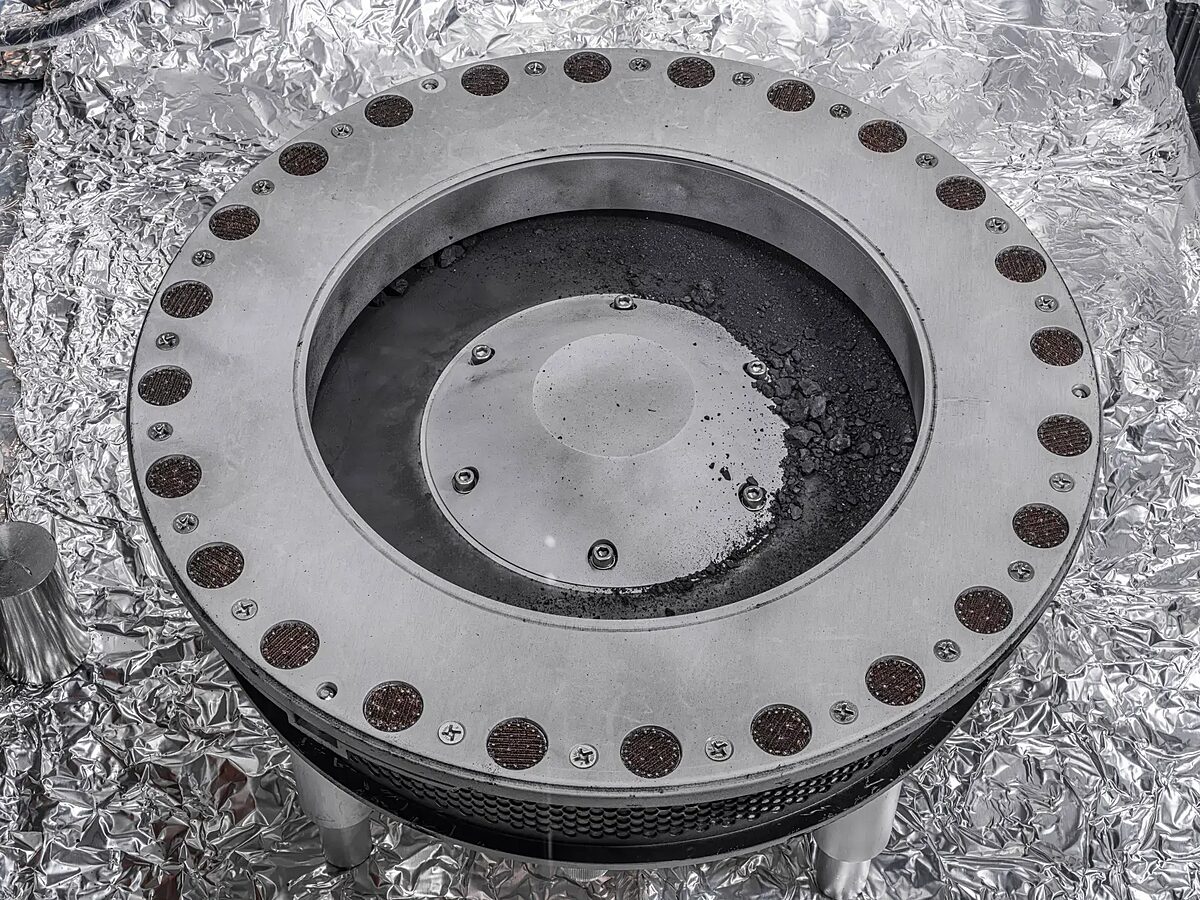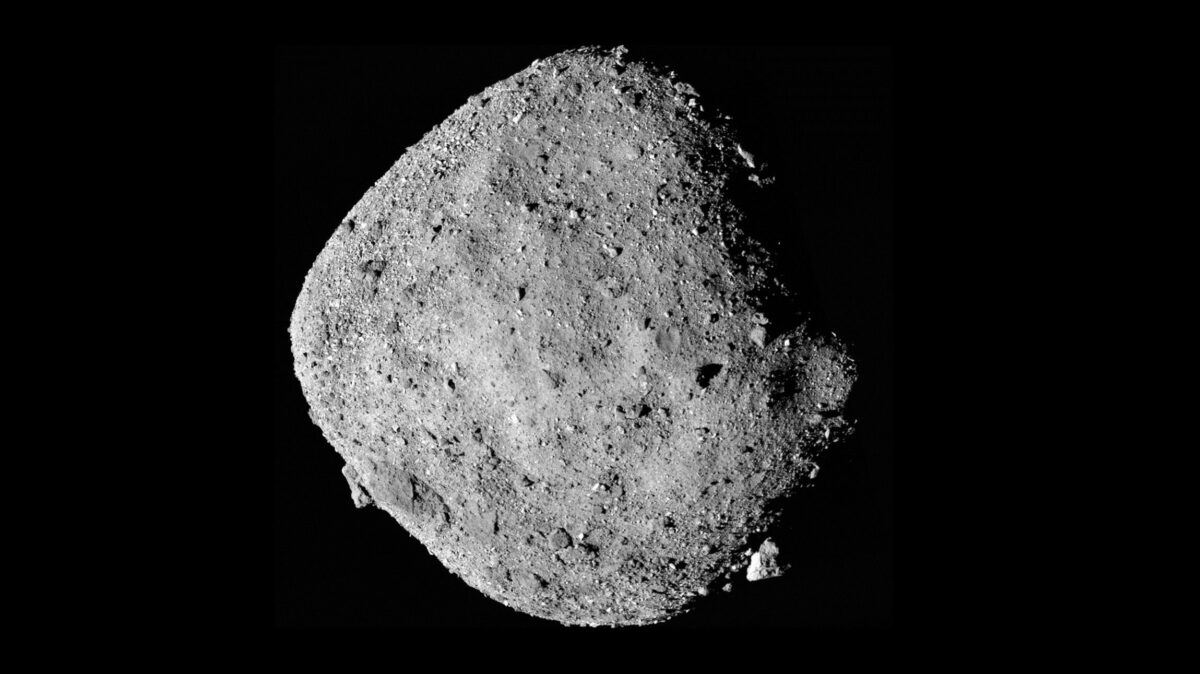OSIRIS-REx, NASA's sample return mission to asteroid Bennu
Highlights
- OSIRIS-REx collected a sample of the asteroid Bennu in 2020 and returned it to Earth in 2023.
- In 2025, scientists announced the sample contained many of the building blocks of life.
- By bringing back pieces of Bennu, we are learning how common the conditions needed for life are throughout the Solar System.
Why did we collect a sample from asteroid Bennu?
Our Solar System is filled with countless asteroids, comets, and other small worlds left over from the disk of dust and gas that formed the planets 4.5 billion years ago. Some of these worlds slammed into the early Earth, possibly seeding our planet with the water and organics needed for life as we know it.
Our planet’s weather and geological processes are constantly altering its surface. By comparison, asteroids remain largely unchanged over time. By studying these worlds, we can learn what our infant Solar System was once like.
Although modern spacecraft instruments can tell us a lot about other worlds, there are certain kinds of experiments that can only be done on Earth.
This is why OSIRIS-REx — which stands for Origins, Spectral Interpretation, Resource Identification, Security-Regolith Explorer — brought back a sample of an asteroid to Earth in 2023. The spacecraft launched in September 2016, arrived at the asteroid Bennu in December 2018, and successfully collected a sample from it in October 2020. OSIRIS-REx returned the asteroid sample to Earth in September 2023. The Bennu samples were found to contain water, amino acids, and nucleobases — key ingredients for life as we know it.

What is OSIRIS-REx doing now?
After dropping off the sample collection capsule with the material from Bennu, OSIRIS-REx diverted away from Earth. Its eventual goal is the potentially hazardous asteroid Apophis. On April 13, 2029, Apophis will pass closer to Earth than some geostationary satellites, at a distance of 30,600 kilometers (19,000 miles) from Earth. The OSIRIS-REx spacecraft will spend 18 months studying the asteroid up close. To go with its new target, the mission has taken on a new name: OSIRIS-APEX, short for OSIRIS-Apophis Explorer.
How much does OSIRIS-REx cost?
NASA’s OSIRIS-REx mission, which is part of the agency’s New Frontiers program, is projected to cost $1.16 billion over 15 years. This may seem large, but it is a very small amount in the larger context of the U.S. budget.
What is the OSIRIS-REx spacecraft like?
OSIRIS-REx is about the size of a van, weighing in at more than 2 metric tons with all of its fuel. The probe, which was built by Lockheed Martin Space Systems, has a 3-meter-long (10-foot-long) sample arm and solar panels that fold back. This gave it extra room to maneuver near Bennu’s surface and protected it from debris kicked up during sample collection.
The spacecraft's small instrument deck is packed with science gear. There’s the OSIRIS-REX Laser Altimeter (OLA), which scanned the surface of Bennu with lidar. There are multiple spectrometers that mapped the asteroid’s composition, including the OSIRIS-REx Visible and IR Spectrometer (OVIRS), the OSIRIS-REx Thermal Emission Spectrometer (OTES), and the Regolith X-Ray Imaging Spectrometer (REXIS). There’s the touch-and-go sample acquisition mechanism (TAGSAM) that actually grabbed the material off the asteroid. And there’s the OSIRIS-REX Camera Suite (OCAMS), which is made up of three separate cameras: PolyCam that imaged the asteroid from orbit, MapCam that mapped it, and SamCam that photographed the sampling.

How OSIRIS-REx worked
Upon arrival at Bennu, OSIRIS-REx found the asteroid much rockier than expected, with no areas that met the mission's original safety criteria for collecting a sample. Fortunately, the spacecraft navigates with high precision, comparing the view from its cameras to stored images of Bennu’s landscape. This allowed scientists to settle on a sample site no larger than a few parking spaces.
In October 2020, OSIRIS-REx collected a sample by high-fiving Bennu with a cylindrical device called TAGSAM at the end of its sample arm. Upon touching the asteroid, TAGSAM fired a blast of nitrogen gas into the surface, stirring rocks and soil into a small collection chamber. The operation was so successful at grabbing samples that a flap on the collection chamber was jammed open by all the asteroid material.
Three years later, OSIRIS-REx returned samples of the potentially hazardous asteroid Bennu to Earth, becoming the first U.S. mission ever to bring back material from an asteroid. The pieces of Bennu, which were contained safely inside a sample return capsule, reentered Earth’s atmosphere and touched down at the Department of Defense’s Utah Test and Training Range. There, they were collected by members of the OSIRIS-REx team. After some trouble with the capsule’s fasteners, the sample of asteroid Bennu is now being analyzed by NASA's Astromaterials Research and Exploration Science Directorate (ARES) and at Japan's Extraterrestrial Sample Curation Center.
What did OSIRIS-REx teach us about defending Earth from asteroids?
Bennu is a near-Earth asteroid, meaning its orbit carries it close to Earth. Small worlds like Bennu, which is just 500 meters (a third of a mile) across, can have their orbits altered by small forces like heat emission in ways we don’t fully understand. These forces can add up over time and mean the difference between an asteroid missing Earth or slamming into it. OSIRIS-REx studied one of these forces, called the Yarkovsky effect.
OSIRIS-REx touches Bennu NASA's OSIRIS-REx spacecraft successfully collected a sample from asteroid Bennu on October 20, 2020.Video: NASA Goddard
Planetary Society involvement
We helped name asteroid Bennu!
In 2013, The Planetary Society, the University of Arizona, and MIT held a naming contest for OSIRIS-REx's target asteroid, which was then formally known as 1999RQ36. 9-year-old Michael Puzio won the competition with his proposed name Bennu, after a deity from ancient Egyptian mythology.
"Bennu was a large heron and the living symbol of Osiris. The winged OSIRIS-REx and its heron-like TAGSAM also evoke attributes of Bennu, as does the egg shape of the asteroid itself. Bennu means 'The Ascending One', 'to shine' and suits the NEO which will shine in our skies in 2023 at the return of OSIRIS-REx."

We also collected names to travel aboard OSIRIS-REx through our Messages from Earth program. If you sent your name, you can look up your certificate here.
Sample collection is a very important tool for planetary scientists to study our Solar System. Find out how we're working to reduce the cost of sample collection with PlanetVac.
Academic resources
- Lauretta, D. S., Balram-Knutson, S. S., Beshore, E., Boynton, W. V., Drouet d’Aubigny, C., DellaGiustina, D. N., Enos, H. L., Golish, D. R., Hergenrother, C. W., Howell, E. S., Bennett, C. A., Morton, E. T., Nolan, M. C., Rizk, B., Roper, H. L., Bartels, A. E., Bos, B. J., Dworkin, J. P., Highsmith, D. E., … Sandford, S. A. (2017). Osiris-Rex: Sample return from asteroid (101955) Bennu. Space Science Reviews, 212(1-2), 925–984.
Support missions like OSIRIS-REx
Whether it's advocating, teaching, inspiring, or learning, you can do something for space, right now. Let's get to work.


 Explore Worlds
Explore Worlds Find Life
Find Life Defend Earth
Defend Earth


